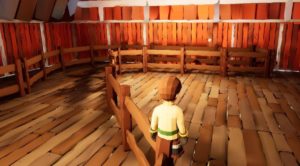Teaching animal science through interactive gaming

CowSim helps educate those with little to no cattle experience understand the processes behind working cattle before stepping out into real-world scenarios. (Photo courtesy of the Department of Animal Science.)
COLLEGE STATION — For students studying animal science, interactive gaming can now help introduce concepts of working with cattle, before they’ve even stepped foot in a pen or pasture.
Nicholas Free, animal science senior at Texas A&M University’s College of Agriculture and Life Sciences didn’t grow up handling cattle, but he created a simulation that may help others build and expand their cattle-working skills.
Free created an interactive simulation game to focus on the best techniques to handle cattle. It benefits the student, and in turn, benefits the animals as students learn how to keep cattle calm, cool and collected when moving from one place to another, Free said.
During the spring of 2019, Free attended a presentation by Ron Gill, Ph.D., Texas A&M professor and Texas A&M AgriLife Extension Service livestock specialist, about proper cattle handling methods and techniques. Free said he was surprised at how many questions the audience had about the methods used.
Working cattle in a virtual world
“I didn’t have much experience with livestock, but I understood the concepts immediately,” Free said. “I began thinking about how I could help people visualize the concepts without having hands-on experience.”
Free expanded on the idea by networking with Texas A&M faculty and researching how to create video games in augmented reality.
“I started reading the Unreal Engine 4 manual,” Free said. The Unreal Engine 4 manual is an online introductory tool for developers starting out on video game creation.
Everything started to progress even further after meeting with Luis Tedeschi, Ph.D., associate professor for animal nutrition and Texas A&M AgriLife Research Faculty Fellow.
“Everything changed when I met Dr. Tedeschi,” Free said. “He gave me the incentive and opportunity to create my first game simulation ever.”
Free imagined a virtual world in which he could teach students how to behave in the presence of cattle. According to Tedeschi, all Free needed was for someone to listen to his ideas and challenge him to use the fundamentals he had learned.
“Free needed to talk to someone about his ideas,” Tedeschi said. “He needed some incentive and time to express himself. After some brainstorming and challenging thoughts, he knew what to do.”
Free hit the ground running designing the game’s layout. With a little help from Tedeschi, Free’s brother, Richard Toussaint III and fellow programmer Kazim Hasan, the game became a reality, and CowSim was born.
CowSim

In the second section of the game, players learn the proper techniques needed for driving cattle in a production facility. (Photo courtesy of the Department of Animal Science.)
CowSim is separated into three parts; the first section is designated to teach the player how to behave in an open environment with cattle. In the second section, players learn the proper techniques needed for driving cattle in a production facility. In the last section, players apply their knowledge from the previous sections by leading the cattle through the facility with additional obstacles.
Engaging new audiences through augmented reality
According to Free, the main goal of this game is for players to learn how to handle livestock in the real world and feel comfortable doing so. This alternative teaching method can help provide sufficient knowledge for students, who have trouble maintaining information from the traditional classroom or have never had the opportunity to learn from within the industry, Free said.
“Overall, I feel very comfortable saying that if a person – who has never had any interaction with livestock – were to play this game, they would have sufficient knowledge on how to handle them by the end of the game,” Free said. “I hope we can start the process of interactive learning through simulation and games as a model to be used in the education system.”
Moving beyond traditional teaching methods
According to Tedeschi, times have changed in academia, and certain students may require a non-traditional teaching method.
“Traditional teaching methods may not be as effective as before, and given the media orientation of our clientele, video games provide an exciting opportunity to catch their attention and deliver the desired information,” Tedeschi said. “The combination of educational gaming and virtual reality has the potential to attract a greater audience and deliver the same information through interactive gaming rather than the traditional spoken, lectureship classes.”
Tedeschi said he believes this is only the beginning for Free, and the start of the transition to alternative teaching methods throughout the Department of Animal Science. For more information about CowSim and Free’s future projects, email Free at free.nicholas@tamu.edu.
Original article can be found at Teaching animal science through interactive gaming.
